
25 Agile Best Practices for High-Performing Teams in 2024 Search
Cloudwards.net may earn a small commission from some purchases made through our site. However, any earnings do not affect how we review services. Learn more about our editorial integrity and research process.
Why you can trust us
- 407 Cloud Software Products and Services Tested
- 3056 Annual Software Speed Tests
- 2400 plus Hours Usability Testing
Our team of experts thoroughly test each service, evaluating it for features, usability, security, value for money and more. Learn more about how we conduct our testing.
Key Takeaways: What Are Some Top Agile Best Practices?
- Encouraging self-organizing teams is the foundation of successful agile teams, as it empowers teams to take ownership of their work and decision-making.
- Engage the entire team in sprint planning sessions to ensure a shared understanding of goals and tasks.
- Effectively leverage agile artifacts like product backlogs, task boards and user stories to streamline product development.
- Use kanban boards to visualize entire workflows, identify bottlenecks and manage flow.
- Adopt continuous integration and delivery practices to enable frequent, reliable releases and early feedback from stakeholders.
What to Know About Agile Teams:
- Agile benefits: Implementing agile teams can improve productivity, enhance customer satisfaction and better align with business objectives.
- Areas of responsibility: Clearly define the roles of the Scrum Master, Product Owner and development team to ensure smooth team collaboration and accountability.
- Maintaining team cohesion on a global scale: Implementing consistent tools, creating overlapping hours and leveraging scaling frameworks can help global agile teams maintain alignment and transparency.
Agile methodologies and frameworks provide a solution for organizations looking to improve their teams’ effectiveness and productivity. These proven methods, along with using some of the best project management software platforms and some of the best agile tools, help teams adapt quickly to change, collaborate effectively and deliver successful outcomes.
In this article, we have curated essential agile best practices that can improve your team’s workflow and project success. You’ll learn what agile project management is and the benefits of being agile, and we’ll share 25 best practices that span different agile project management methodologies. Let’s get started.
Meet the experts
Learn more about our editorial team and our research process.
What Is Agile Project Management?
Agile project management is a flexible and iterative approach to managing multiple projects. The agile method allows teams to collaborate effectively and adjust to changes throughout the project’s life cycle rather than following a strict plan from start to finish like traditional project management methods.
Some popular agile frameworks include Scrum, kanban and extreme programming (XP). While each framework has unique characteristics, they all share the common goal of improving efficiency, enhancing collaboration and delivering high-quality products that meet the client’s needs.
Why You Need to Implement Agile Teams
Agile software development can bring many benefits to your development team, such as improved productivity, enhanced customer satisfaction and better alignment with business objectives. Furthermore, the collaborative nature of agile teams encourages communication, transparency and shared accountability, which lead to better project outcomes.
Agile teams are commonly associated with software development. However, a variety of organizations can benefit from agile teams, such as marketing departments and customer service teams. Even small businesses can adopt agile practices to quickly respond to market changes and customer needs.
Understanding the Agile Manifesto
The agile manifesto, introduced in 2001, outlines the core values and principles of agile software development. These include individuals and interactions over processes and tools, working software over comprehensive documentation, customer collaboration over contract negotiation and responding to change over following a plan.
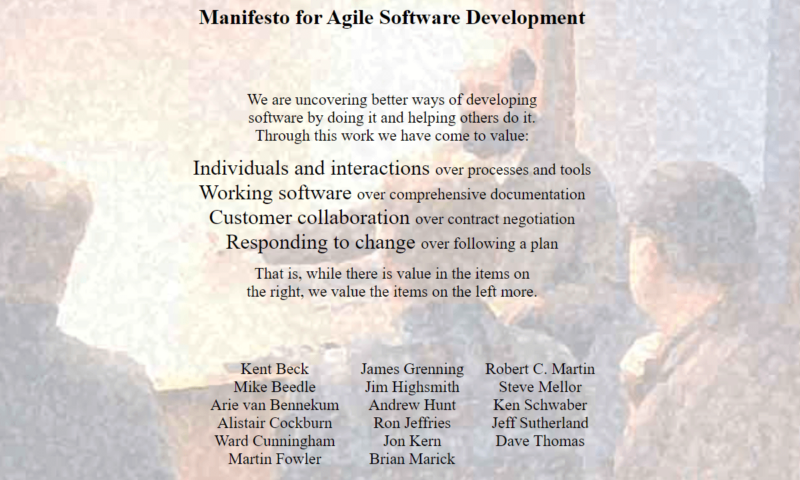
The agile manifesto is a set of guiding principles that prioritize continuous improvement, collaboration and flexibility in software project management.
25 Agile Best Practices
Now that you know what agile is and how your team can benefit from being agile, let’s explore agile best practices that can empower teams toward success in agile development. We’ll start by looking at general agile best practices before moving on to specific agile frameworks.
6 General Agile Best Practices
No matter what Agile framework you choose to work with, there are certain best practices that apply no matter what.
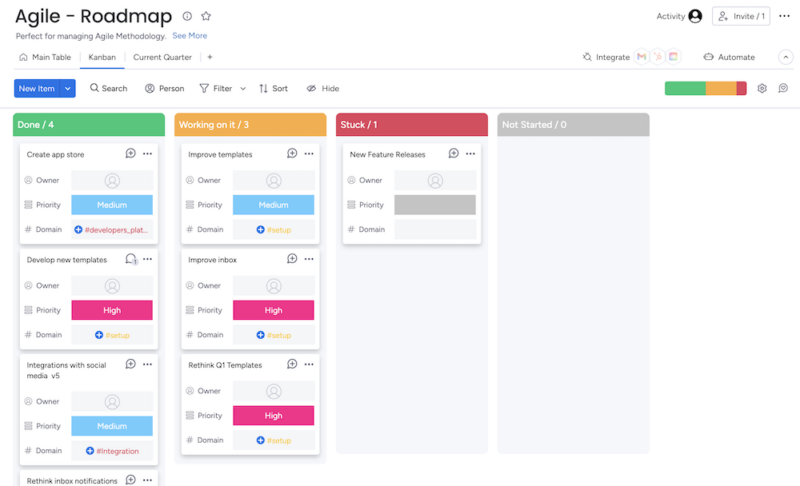
monday.com is the best project management tool for project teams
that want to effectively implement agile practices.
- Foster self-organizing teams: Empowering team members to take ownership of their work, make decisions and collaborate within the organization can lay a strong foundation for adapting agile principles.
- Collaborate with customers: Teams must establish effective communication channels with stakeholders and customers. This way, team members can deliver value more effectively in response to the customer’s competitive advantage and specific needs.
- Adopt iterative development: By breaking down a project into smaller, more manageable chunks known as sprints, agile teams can frequently deliver working software during sprint reviews and receive feedback early on in the development process.
- Embrace continuous improvement: Continuously seek ways to improve the agile development process. For example, consider using open-source software or cheap project management tools for cost-efficiency, adopting new technologies and automating processes.
- Build cross-functional teams: Promote collaboration between team members with diverse skills, such as developers, designers and testers. This practice encourages shared knowledge, leading to more innovative and well-rounded product outcomes.
- Celebrate achievements: Acknowledge milestones and completed tasks to boost team morale and encourage ongoing success.
7 Scrum Framework Best Practices: Roles, Ceremonies and Artifacts
Scrum is one of the more popular agile methodologies used on software development teams. In Scrum, team members work in sprints, collaborate closely and regularly review progress to meet changing project requirements. Let’s take a look at some agile practices for effectively implementing the Scrum framework.
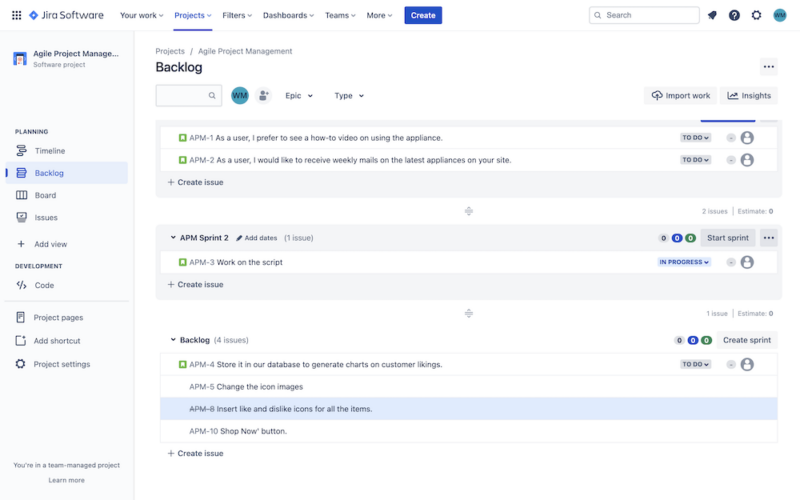
Jira is a top-notch agile software development
tool for software development teams.
- Clarify roles and responsibilities: Clearly define the roles of the Product Owner, Scrum Master and development team members to ensure smooth collaboration and accountability.
- Conduct effective sprint planning: Engage the entire team in sprint planning to ensure a shared understanding of goals, commitments and tasks.
- Facilitate daily standups: Encourage face-to-face communication by conducting daily standup meetings, where agile teams can track progress and discuss everyday tasks together.
- Run regular retrospectives: After each sprint, hold a sprint retrospective meeting to reflect on what went well, what could be improved and how to enhance team performance. Use this insight to improve the next sprint.
- Utilize agile artifacts effectively: Visualize agile processes using agile artifacts like product backlogs, task boards and user stories. Read our Jira review and monday.com review to see how you can use these tools to organize Scrum artifacts.
- Prioritize product backlog refinement: Regularly refine the product backlog with input from stakeholders to make sure that it aligns with current requirements and facilitates efficient sprint planning.
- Establish a clear definition of done (DoD): DoD indicates criteria for completing a task or user story successfully. This helps prevent misunderstandings and ensures quality deliverables.
6 Kanban Methodology Best Practices: Visualizing Work and Limiting WIP
Kanban methodology is a visual method for managing agile projects as they move through a process. This helps agile teams visualize their workflow, identify bottlenecks and optimize the flow of work. Here are some kanban best practices to follow.
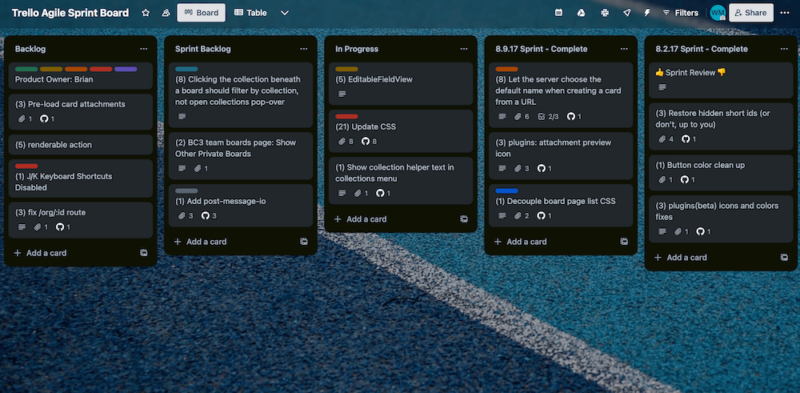
A kanban board, like those found in Trello, is an excellent tool
for agile teams to visualize work and track progress.
- Visualize the workflow: Create a kanban board with different stages of your workflow, such as “to do,” “in progress” and “done.” This visual representation helps each team member understand task status at a glance. Be sure to check out our roundup of the best kanban tools.
- Prioritize tasks: Assign priorities to tasks based on their importance and urgency. This helps teams focus on high-priority items and maintain productivity.
- Limit work in progress (WIP): Restrict the number of tasks in each stage of the workflow to maintain focus and avoid bottlenecks. This also prevents any team member from taking on too many tasks.
- Define clear policies: Clearly outline the rules and criteria for moving tasks between different stages on the kanban board. This helps team members make better decisions about prioritizing and advancing tasks, resulting in more efficient project development.
- Monitor the flow: Identify any areas where workflows are blocked or slowing down and address them promptly. Let team members share their insights and ideas on how to improve the workflows and make necessary changes.
- Enter the necessary card details: Each kanban card should contain all essential information, including descriptions, deadlines and relevant links or attachments. This allows team members to work on tasks without any confusion and speeds up the workflow.
6 Extreme Programming (XP) Best Practices: Emphasizing Technical Excellence
Extreme programming (XP) is a software development framework that focuses on improving software quality through frequent releases and close collaboration between the development team and customers. We will explore some XP best practices for your agile software development project.
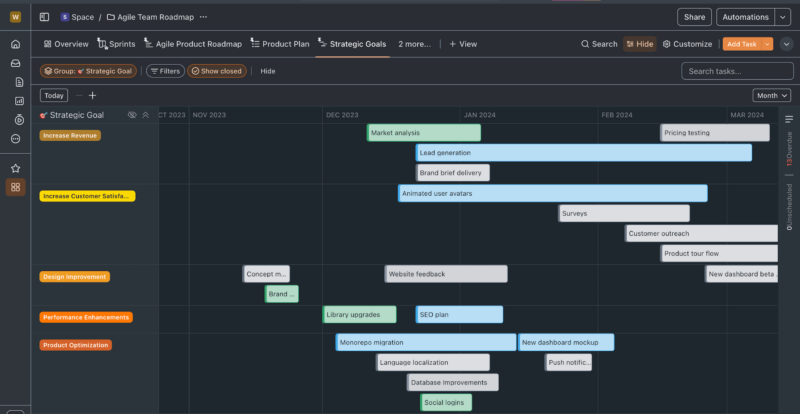
ClickUp is a project management tool that can help streamline
iterative processes and enhance team collaboration.
- Promote pair programming: Two programmers work together on one computer to design, code and test user stories. This practice improves code quality and helps with knowledge sharing and problem-solving.
- Practice test-driven development (TDD): Developers write tests before writing the actual code and then refactor the code until it passes the test. This practice helps reduce bugs and ensures code quality.
- Regularly refactor code: Refactoring code is the process of consistently reviewing and improving existing code without changing the original functionality to make it simpler and clearer. Refactoring helps developers detect bugs and leads to more reliable and efficient software development.
- Continuous integration: This practice involves frequently integrating code changes into a shared repository several times a day. This process helps identify issues early and improves overall product quality.
- Keep design simple: XP emphasizes simplicity in design to avoid unnecessary complexity that can lead to confusion. Teams should aim to create straightforward, clean code, making future changes easier to implement.
- Collective code ownership: Everyone on the team has collective responsibility for the entire codebase. This practice encourages knowledge sharing and makes sure that everyone takes ownership of the team’s code quality.
Scaling Agile for Global Teams
As organizations grow and teams become distributed across different locations and time zones, scaling agile practices becomes essential to maintaining team performance. Here are some best practices for scaling global agile teams:
- Implement consistent tools: Use consistent tools and platforms across agile teams for project management, communication and task tracking. This will ensure smooth collaboration. Here are recommended tools for global software startups.
- Introduce cultural training: Provide training sessions to raise cultural awareness among team members from diverse backgrounds. Understanding cultural differences can enhance communication, build trust and lead to a more inclusive work environment.
- Create overlapping hours for collaboration: Consider scheduling overlapping hours where teams from different regions can connect in real time. Project managers and Scrum Masters can then conduct important meetings during this time, such as retrospectives and daily standups.
- Empower local leaders: Designate agile champions or Scrum Masters in each region to assist with local decision-making and problem-solving.
- Leverage frameworks for scaling agile: Implement frameworks such as the scaled agile framework (SAFe) or the Scrum of Scrums, which provide structured guidance for applying agile practices at scale.
Benefits of Agile Methodology
Now that you understand the key principles and best practices of agile project management methodology, let’s explore some of the benefits that come with implementing it in your organization.
1. Flexibility and Adaptability: Responding to Change
Agile methods allow teams to quickly respond to changes in project requirements, priorities and market conditions. Individual team members can adjust the strategies and plans as needed to ensure the project stays on track and delivers value.
2. Faster Product Delivery: Accelerating Time to Market
By embracing an agile approach, teams can prioritize the early and continuous delivery of a minimum viable product (MVP). Instead of waiting for a perfect final product, this development process accelerates the time to market and allows for quick feedback loops.
3. Risk Reduction: Early and Continuous Feedback
Early input from stakeholders and end users can help identify possible risks and issues at an early stage of the product development process. The constant feedback loop also lets teams quickly make necessary adjustments. This lowers the risk of project failure and ensures the final product meets customer expectations.
4. Enhanced Product Quality: Iterative Development & Improvement
Agile teams build projects through iterative cycles, continuously refining the product based on feedback. Furthermore, test-driven development (TDD) in the agile approach ensures thorough testing of each feature before integration, reducing the chances of bugs or defects slipping through.
5. Increased Business Value: Aligning with Customer Needs
Agile development prioritizes value-based business priorities and customer needs. Businesses can ensure they are delivering the most efficient processes and products, resulting in high customer satisfaction and increased business value.
Challenges and Solutions in Agile Software Development
While agile project management methods offer many benefits, organizations may face challenges during implementation. Here are some common challenges and potential solutions:
- Inadequate team collaboration: Lack of efficient and effective interaction on an agile team can lead to misunderstandings, delays and rework. To foster a supportive culture, encourage face-to-face team communication and use collaboration tools.
- Scope creep: Constantly changing project requirements can disrupt timelines and budgets, which can lead to scope creep. Agile teams should set clear project goals from the start, prioritize features based on business value and regularly review and adjust the scope with stakeholders.
- Quality assurance: Ensuring high-quality deliverables within short iterations can be challenging in software development. To address this challenge, integrate automated testing early in the development cycle, follow agile best practices for testing and implement continuous feedback loops.
- Transition from traditional project management: Shifting from traditional project management to agile’s iterative and flexible approach can be difficult for some team members. Agile teams may offer extensive training and progressively implement agile approaches to ease the transition and avoid future issues with anti-patterns.
- Lack of agile expertise: Without a deep understanding of agile principles and practices, teams may struggle to implement them effectively. Companies can invest in agile leadership training and provide workshops and resources for agile teams.
Final Thoughts
Maintaining high-performing agile teams and delivering high-quality products in a changing environment is undoubtedly challenging. However, by implementing agile best practices, teams can overcome difficulties and make agile methods sustainable in the long run.
One key practice is ensuring clear communication. For example, daily standups allow team members to discuss progress, roadblocks and priorities together. Engaging stakeholders and integrating their feedback into development is another essential practice that can increase customer satisfaction. If you follow the tips above, you’ll have no problems implementing agile.
We’d love to hear your thoughts and experiences with implementing agile development practices. Do you have any additional best practices to share? What challenges have you faced during your agile journey, and how did you overcome them? Let us know in the comments below. Thank you for reading!
FAQ: Agile Practices
-
The four principles of agile consist of individuals and interactions over processes and tools, working software over comprehensive documentation, customer collaboration over contract negotiation and responding to change over following a plan.
-
Scrum is the most popular agile framework and involves working in short iterations or sprints to deliver incremental product development.
-
The five steps of agile methodology are envisioning the project, speculating on possible solutions, exploring different options, adapting to change and closing successful projects.
-
The three Cs of agile practice include collaboration, coordination and communication. These emphasize the importance of teamwork, adaptability and customer satisfaction in agile methods.
The four principles of agile consist of individuals and interactions over processes and tools, working software over comprehensive documentation, customer collaboration over contract negotiation and responding to change over following a plan.n”}},{“@type”:”Question”,”name”:”What Is the Most Popular Agile Practice?t”,”acceptedAnswer”:{“@type”:”Answer”,”text”:”
Scrum is the most popular agile framework and involves working in short iterations or sprints to deliver incremental product development.n”}},{“@type”:”Question”,”name”:”What Are the 5 Steps of Agile Methodology?”,”acceptedAnswer”:{“@type”:”Answer”,”text”:”
The five steps of agile methodology are envisioning the project, speculating on possible solutions, exploring different options, adapting to change and closing successful projects.n”}},{“@type”:”Question”,”name”:”What Are the Three Cs of Agile Practice?”,”acceptedAnswer”:{“@type”:”Answer”,”text”:”
The three Cs of agile practice include collaboration, coordination and communication. These emphasize the importance of teamwork, adaptability and customer satisfaction in agile methods.n”}}]}]]>
Let us know if you liked the post. That’s the only way we can improve.
Also interesting
Last published on Cloudwards:
Brett is a freelance journalist with 10 years of experience in the tech industry. Brett has covered everything from smartphones to cameras to software while holding the roles of Tech Columnist and Gear Editor. He writes about project management for Cloudwards. When not behind his desk writing, Brett can be found out and about with one of his many cameras, hiking in the wilderness, playing with his dogs, or playing video games. Brett is a self-confessed coffee addict and will do nearly anything for a good cup of Joe.
Last published on Cloudwards:
Jasna earned her BA in translation and interpreting back in 2011. After working in the IT industry for many years as a content analyst, she took a course in web development in 2017 to learn the basics of front-end engineering. Her love for technology and writing opened a new chapter in her career, leading her to join Cloudwards as a fact-checker. When she’s not fact-checking, you’ll find her running or cycling on the quay of Vardar, listening to Joy Division, watching Star Wars, or eating chocolate and sweets in the local bakeries.
Source

